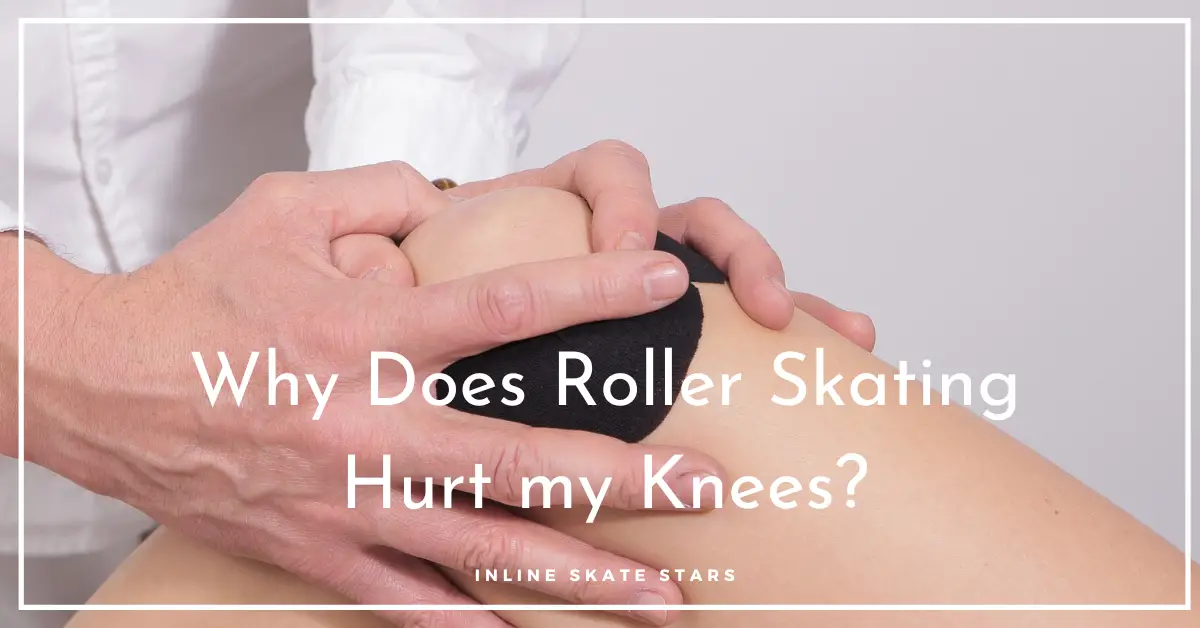Why does roller skating hurt my knees?
Roller skating is a fun and exciting hobby with tons of benefits. Your body releases dopamine hormone when roller skating.
This hormone makes you feel good and turns roller skating into a pleasurable activity. It’s the perfect way to deal with stress and bad days!
But the fun also means nothing when you have knee pain from roller skating. While roller skating is safe for your knees, it can be dangerous when you don’t get it right.
So, if you’re wondering why roller skating hurts your knees, I got you.
I’ve put together this guide to answer your question and to offer tips for how to prevent or treat roller skating knee pains. So, let’s get to it!
Why Does Roller Skating Hurt my Knees?
Roller skating will hurt your knees if you have an existing knee condition like a ligament tear, use the wrong skating technique, have weak knee muscles, overskate, or recently took a hard fall on your knees.
Other possible causes of roller skating knee pains include;
- Pronation and supination
- Wearing ill-fitting roller skates
- Roller skating on rough surfaces
- Performing extreme roller skating tricks
This is only the scratch on the surface. Below are the details of how it works!
1. Existing Knee Condition
Existing knee conditions such as acute meniscus (cartilage) damage and knee ligament tear could be possible reasons your knees hurt when and after roller skating.
The meniscus is the joint between your thigh and shin bones. Its primary role is to absorb the shock from the thigh and shinbones.
Sudden knee twists usually cause meniscus damage, especially when doing roller skating tricks like jumps and turns. You may end up with a torn meniscus if you overdo these tricks.
On the other hand, a knee ligament tear is caused by trauma and sports injuries. You may tear your knee ligaments if you collide with other skaters or run into objects on your roller skating path.
The anterior cruciate ligament (ACL) is often the most affected by torn ligament injuries. While you can roller skate with this condition, the pain can sometimes be too much!
2. Using the Wrong Roller Skating Technique
If you experience roller skating knee pains, the chances are that you use the wrong technique, especially when you’re a beginner.
What is the wrong skating technique? You’re probably asking. Using the wrong skating technique means not bending correctly.
This posture concentrates your body weight on your back and knees, hurting them more.
3. Weak Knee Muscles
Roller skating works all body muscles, especially the lower body muscles. Two primary muscle groups act on the knee joint. They include;
- The quadriceps femoris and
- The posterior compartment of the proximal leg
Roller skating is also intensive and requires stronger knee muscles. Your knees probably hurt because you still have weak knee joint muscles.
4. Overuse Injury from OverSkating
Roller skating is fun, but not when you overdo it. Over skating causes overuse injury by overstretching the knee joint muscles, tendons, and ligaments.
Overstretched muscles, tendons, and ligaments are the primary cause of torn muscles, ACL, and other ligaments.
5. Pronation and Supination
Pronation is when your feet incline inwards at the ankle joint, while supination is when they bend outwards.
Pronation and supination may exert pressure on the knee sides, causing knee pain when roller skating.
According to a Posture Podiatry study, excessive pronation rotates the knees internally, moving both legs into a ‘knock-kneed’ position. This can hurt badly!
6. Wearing Ill-fitting Roller Skates
Ill-fitting roller skates are either tight or loose, causing feet to wobble. The problem with ill-fitting roller skates is the inability to absorb shock when roller skating.
Instead, the shock is channeled to your ankles, shins, and knees, making them hurt more.
7. Roller Skating on Rough Surfaces
There are plenty of surfaces for roller skating, including asphalt, wood, concrete, rubber, and plastic. But roller skating on a rough surface isn’t a good idea.
Most of the vibration energy generated is absorbed by your roller skates and the rest by your body.
If you have ill-fitting roller skates, all the vibrations go to your ankles, shins, and knees, hurting them.
8. Performing Extreme Roller Skating Tricks
Performing roller skating tricks is fun, but they can also cause more harm than good. Some roller skating tricks like sudden jumps and turns and body spins can cause knee pain.
For example, cross-overs can hurt the knee of the leg that stays on the ground, especially when making quick sharp turns. The same is true for jumps and body spins.
You’ll want to avoid high jumps because a wrong landing can lead to torn ACL or a broken knee joint. This will make your knees hurt when and after roller skating.
9. Falling Hard on Your Knees
Falling hard on your knees affects the knee joints. You may end up with torn ligaments or broken knee bones.
You’ll undoubtedly experience pain after a hard fall, especially when you don’t have protection on your knees.
How to Prevent or Treat Roller Skating Knee Pains
Now that you know what causes roller skating knee pain, it’s crucial to learn how to prevent or treat it. Knee pain is the last thing you want to come between you and your skating.
Below are tips for preventing or treating roller skating knee pain!
1. Seek Medical Attention
First off, you want to treat medical attention, especially after a hard fall on your knees or if you have an existing knee condition like torn ligaments.
Some conditions are less severe and can be treated with antibiotics and physiotherapy. On the other hand, others are severe and may require surgery. You can only tell when you visit a doctor!
2. Roller Skate Moderately
Roller skating is fun, but it would be great if you skated moderately. Skating once or twice over the weekends or weekdays for one or two hours is enough.
3. Use the Correct Roller Skating Technique
What is the correct roller skating technique? You’re probably asking. Your knees should be over your toes and shoulders above your hips.
This skating posture transfers your body weight from your knees to your toe balls.
4. Roller Skate More to Strengthen Weak Knee Muscles
While over skating isn’t a good idea, you want to strike a balance to strengthen your weak thigh and knee muscles.
Roller skating for one to two hours is a sweet spot if you’re looking to strengthen your muscles. Everything should be fine in about eight to ten weeks.
5. Wear Protective Gear when Roller Skating
Protective gear goes a long way when roller skating. So, you want to wear knee pads every time you go roller skating to protect the knees in case you fall or collide with other skaters.
I recommend the Triple 8 Saver Series Pack Skate Pads Mens and Triple 8 Saver Series 3-Pack Skate Pads Womens. They’re sturdy and more reliable.
6. Lear How to Fall Correctly
You also want to learn how to fall correctly. Below are excellent tips on how to fall correctly when roller skating!
- Sliding on pads
- Rolling on your shoulders
- Falling on your hips/back
- Rolling your body
I put together this detailed guide on how to fall correctly when roller skating. Feel free to check it out!
7. Avoid Performing Extreme Roller Skating Tricks
Roller skating tricks like cross-overs, body spins, quick turns, and jumps are exciting to perform. But if they cause more harm than good, you should avoid them until you’re ready.
8. Warm up and Stretch Before and After Roller Skating
Muscle tear and soreness occur because of little to no warm-up or stretching. This is why you want to warm up and stretch before and after every roller skating session.
9. Avoid Roller Skating on Rough Surfaces
Rough surfaces aren’t the best for roller skating when you have other smooth and soft roller skating surfaces. It will be best to avoid rough surfaces because they cause more harm than good.
10. Do Yoga to Stretch and Strengthen Muscles
Yoga stretches help achieve muscle strength and flexibility. Asha of Skate fresh recommends Hot yoga and Bikram yoga to remedy knee pain when roller skating.
Yoga strengthens your legs, glutes, and core to support the knee joint—this is a great way to strengthen your weak muscles and give your knees more power.
Why Does Roller Skating Hurt my Knees? Wrapping Up
Why does roller skating hurt my knees? Roller skating primarily hurts your knees because of torn knee ligaments and damaged meniscus.
Roller skating while in pain isn’t a cool experience. The good news is that you have this complete guide for reference. The rule of thumb is to seek medical attention if the pain persists.
That’s it. I hope you found this guide helpful!



